
Horse harness
Encyclopedia
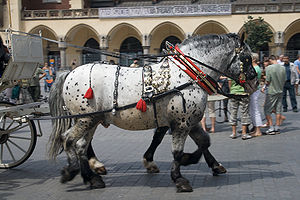
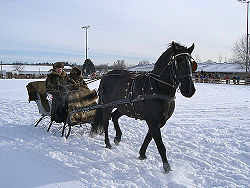
Horse tack
Tack is a term used to describe any of the various equipment and accessories worn by horses in the course of their use as domesticated animals. Saddles, stirrups, bridles, halters, reins, bits, harnesses, martingales, and breastplates are all forms of horse tack...
that allows a horse
Horse
The horse is one of two extant subspecies of Equus ferus, or the wild horse. It is a single-hooved mammal belonging to the taxonomic family Equidae. The horse has evolved over the past 45 to 55 million years from a small multi-toed creature into the large, single-toed animal of today...
or other equine to pull various horse-drawn vehicle
Horse-drawn vehicle
A horse-drawn vehicle is a mechanized piece of equipment pulled by one horse or by a team of horses. These vehicles typically had two or four wheels and were used to carry passengers and/or a load...
s such as a carriage
Carriage
A carriage is a wheeled vehicle for people, usually horse-drawn; litters and sedan chairs are excluded, since they are wheelless vehicles. The carriage is especially designed for private passenger use and for comfort or elegance, though some are also used to transport goods. It may be light,...
, wagon
Wagon
A wagon is a heavy four-wheeled vehicle pulled by draught animals; it was formerly often called a wain, and if low and sideless may be called a dray, trolley or float....
or sleigh. Harnesses may also be used to hitch animals to other loads such as a plow
Plough
The plough or plow is a tool used in farming for initial cultivation of soil in preparation for sowing seed or planting. It has been a basic instrument for most of recorded history, and represents one of the major advances in agriculture...
or canal boat
Narrowboat
A narrowboat or narrow boat is a boat of a distinctive design, made to fit the narrow canals of Great Britain.In the context of British Inland Waterways, "narrow boat" refers to the original working boats built in the 18th, 19th, and 20th centuries for carrying goods on the narrow canals...
.
There are two main categories of horse harness, "breaststrap" or "breastcollar" design and the collar and hames design. For light work, such as horse show
Horse show
A Horse show is a judged exhibition of horses and ponies. Many different horse breeds and equestrian disciplines hold competitions worldwide, from local to the international levels. Most horse shows run from one to three days, sometimes longer for major, all-breed events or national and...
competition where light carts are used, a harness needs only a breastcollar. It can only be used for lighter hauling, since it places the weight of the load on the sternum
Sternum
The sternum or breastbone is a long flat bony plate shaped like a capital "T" located anteriorly to the heart in the center of the thorax...
of the horse and the nearby windpipe. This is not the heaviest skeletal area; also heavy loads can constrict the windpipe and reduce a horse's air supply.
By contrast, the collar and hames harness places the weight of the load onto the horses shoulders, and without any restriction on the air supply. For heavy hauling, the harness must include a horse collar
Horse collar
A horse collar is a part of a horse harness device used to distribute load around a horse's neck and shoulders when pulling a wagon or plow. The collar often supports and pads a pair of curved metal or wood pieces, called hames, to which the traces of the harness are attached...
to allow the animal to use its full weight and strength.
Harness components designed for other animals (such as the yoke
Yoke
A yoke is a wooden beam, normally used between a pair of oxen or other animals to enable them to pull together on a load when working in pairs, as oxen usually do; some yokes are fitted to individual animals. There are several types of yoke, used in different cultures, and for different types of oxen...
used with oxen) are not suitable for horses and will not allow the horse to work efficiently.
Putting harness on a horse is called harnessing or harnessing up. Attaching the harness to the load is called putting to (British Isles
British Isles
The British Isles are a group of islands off the northwest coast of continental Europe that include the islands of Great Britain and Ireland and over six thousand smaller isles. There are two sovereign states located on the islands: the United Kingdom of Great Britain and Northern Ireland and...
) or hitching (North America
North America
North America is a continent wholly within the Northern Hemisphere and almost wholly within the Western Hemisphere. It is also considered a northern subcontinent of the Americas...
). The order of putting on harness components varies by discipline, but when a horse collar is used, it is usually put on first.
Parts of the harness
.png)
- A collar to allow the horse to push against the harness with its shoulders and chest. Two main alternative arrangements (with some intermediate types):
- A horse collarHorse collarA horse collar is a part of a horse harness device used to distribute load around a horse's neck and shoulders when pulling a wagon or plow. The collar often supports and pads a pair of curved metal or wood pieces, called hames, to which the traces of the harness are attached...
(or full collar). A padded loop fitting closely around the horse's neck, pointed at the top to fit the crest of the neck. Used for heavier pulling, especially when used without a swingletreeSwingletreeA swingletree or singletree is a wooden or metal bar used to balance the pull of a draught horse or other draught animal when pulling a vehicle. It is a kind of whippletree, and the term is also used sometimes for other whippletrees.It is a horizontal bar, attached or suspended in the middle,...
or whippletreeWhippletree (mechanism)A whippletree or whiffletree is a mechanism to distribute force evenly through linkages. The mechanism may also be referred to as an equalizer, leader bar or double tree. It consists of a bar pivoted at or near the centre, with force applied from one direction to the pivot, and from the other...
. - A breastcollar. A padded strap running around the chest from side to side. Used for light work, or for somewhat heavier work it is used together with a swingletree or whippletree to allow each shoulder to pull evenly on each step without rubbing.
- A horse collar
- HameHameHame or hames may refer to:*Häme, a province of Finland*Hames, a pair of curved metal pieces lying on the horse collar of a horse harness, taking the pull from the traces...
s (if a full collar is used). Two metal or wooden strips which take the full force of the pull, padded by the collar. - BreechingBreeching (tack)Breeching is a strap around the haunches of a draft, pack or riding animal. Both under saddle and in harness, breeching engages when an animal slows down or travels downhill and is used to brake or stabilize a load.-Harness breeching:...
(icon). A strap around the horse's haunches allowing it to set back and slow a vehicle, usually hooked to the shafts or pole of the vehicle. Used for a single horse, a pair, or in a larger team, only for the wheelers (the animal or pair closest to the vehicle). The leaders in a team do not have breeching, as they are in front of the shafts or pole and so cannot slow the vehicle. Breeching may also be omitted in fine harnessFine harnessFine harness is a type of driving competition seen at horse shows, that feature light, refined horses with high action. Popular breeds in this event include the American Saddlebred, Morgan, Arabian, Dutch Harness Horse, and Hackney ....
, or when the cart is very light or has efficient brakes on the wheels. - TracesTrace (tack)In transport, a trace is one of two, or more, straps, ropes or chains by which a carriage or wagon, or the like, is drawn by a harness horse or other draught animal. The once popular idiom: "kick over the traces" comes from a frisky animal kicking one or both feet outside a trace...
. The straps or chains which take the pull from the breastcollar or hames to the load. - Harness saddleHarness saddleA harness saddle is an element of horse harness which supports the weight of shafts or poles attaching a vehicle to a horse. Like other types of saddle, it lies on the horse's back directly behind the withers, often has an internal supportive framework, often called a saddle tree, and usually is...
, or "pad". A small supportive piece of the harness that lies on the horse's back, not the same as a riding saddleSaddleA saddle is a supportive structure for a rider or other load, fastened to an animal's back by a girth. The most common type is the equestrian saddle designed for a horse, but specialized saddles have been created for camels and other creatures...
. - GirthGirth (tack)A girth, sometimes called a cinch , is a piece of equipment used to keep the saddle in place on a horse or other animal. It passes under the barrel of the equine, usually attached to the saddle on both sides by two or three leather straps called billets...
. A strap that goes firmly around the girth of the horse to attach the harness saddle. - Belly-band. A strap that goes more loosely under the belly of the horse, outside the girth. Prevents the shafts rising up, especially on a two-wheeled vehicle (where weight on the rear of the cart may tip the front up).
- Back band. A strap going through the harness saddle to join the belly band either side. Takes the weight of the shafts or pole. In cart harness it is replaced by a chain running in a groove in the harness saddle, hooked to the shafts either side.
- Sliding back band. In a two-wheeled vehicle the shafts are fixed to the vehicle to hold it level. On a side-slope, one shaft will be higher than the other, and in this case the back band is normally allowed to slide sideways through the harness saddle, so the horse can walk upright without strain on the harness.
- Fixed back-band. In a four-wheeled vehicle the shafts or pole must be allowed to hinge up and down, to allow the horse and vehicle to pass over hillocks and dips. Often the shafts are independently hinged, and on a side-slope these will each hinge to follow the horse, and a sliding back band is not needed. However, if a sliding back band was used with independent shafts it might allow one shaft to ride up higher than the other, and so for such shafts the back-band is normally fixed to the harness saddle. On other four-wheeled vehicles the two shafts hinge together, and a sliding back band is needed as for two-wheeled vehicles.
- SurcingleSurcingleA surcingle is a strap made of leather or leather-like synthetic materials such as nylon or neoprene, sometimes with elastic, that fastens around a horse's girth area. A surcingle may be used for ground training, some types of in-hand exhibition, and over a saddle or horse pack to stabilize the load...
: term used within certain light fine harnessFine harnessFine harness is a type of driving competition seen at horse shows, that feature light, refined horses with high action. Popular breeds in this event include the American Saddlebred, Morgan, Arabian, Dutch Harness Horse, and Hackney ....
designs to describe the combination of a light girth and harness saddle. - False martingale. A strap passing between the front legs, from the centre of the collar to the belly band, to hold the collar in position. Called "false", because unlike a true martingaleMartingaleMartingale can refer to:*Martingale , a stochastic process in which the conditional expectation of the next value, given the current and preceding values, is the current value*Martingale for horses...
it does not attach to the bridle or have any influence on the horse's action. - CrupperCrupperA crupper is a piece of tack used on horses and other equids to keep a saddle, harness or other equipment from sliding forward.-Construction:...
. A soft padded loop under the base of the tail, to keep the harness from slipping forward. - Back strap. A strap attached by looping through the crupper D at the rear of the saddle / pad or surcingle to attach the crupper
- Shaft tugs, or just tugs. Loops attached to the back band to hold up the shafts of a vehicle in van or fine harness (not needed in cart harness, which attaches to hooks on the shafts). Two types:
- For two-wheeled vehicles the tugs are stiff leather loops, fitting fairly loosely around the shafts (which are rigidly attached to the vehicle), to allow flexibility as the animal and the vehicle move against each other.
- For four-wheeled vehicles with independently hinged shafts, the tugs (Tilbury tugs) are leather straps buckled tightly around the shafts so they move with the animal.
- TerretTerretA terret is a metal loop on horse harness, guiding the reins and preventing them from becoming tangled or snagged on the harness.The reins run from the hands of the driver, through the terrets, and then attach to the horse's bit to guide the horse...
s. Metal loops on the saddle and collar to support the reins. The bridles of the rear animals of a large team may also have terrets to take the reins of the animals to the front of them. - ReinReinReins are items of horse tack, used to direct a horse or other animal used for riding or driving. Reins can be made of leather, nylon, metal, or other materials, and attach to a bridle via either its bit or its noseband.-Use for riding:...
s. Long leather straps (occasionally ropes) running from the bitBit (horse)A bit is a type of horse tack used in equestrian activities, usually made of metal or a synthetic material, and is placed in the mouth of a horse or other equid and assists a rider in communicating with the animal. It rests on the bars of the mouth in an interdental region where there are no teeth...
to the driver's hands, used to guide the horses. In teams of several animals these may be joined together so the driver only need hold one pair.
- BridleBridleA bridle is a piece of equipment used to direct a horse. As defined in the Oxford English Dictionary, the "bridle" includes both the headstall that holds a bit that goes in the mouth of a horse, and the reins that are attached to the bit....
: When working in harness, most horses wear a specialised bridle that includes features not seen in bridles used for riding. These usually include blindersBlindersBlinders, also known as blinkers or winkers, are a piece of horse tack that prevent the horse seeing to the rear and, in some cases, to the side. They usually are made of leather or plastic cups that are placed on either side of the eyes, either attached to a bridle or to an independent hood...
, also called blinkers or winkers, behind and to the side of the horse's eyes, to prevent it from being distracted by the cart and other activity behind it. Harness racingHarness racingHarness racing is a form of horse racing in which the horses race at a specific gait . They usually pull a two-wheeled cart called a sulky, although racing under saddle is also conducted in Europe.-Breeds:...
horses sometimes have a shadow rollShadow rollA shadow roll is a piece of equipment, usually made of sheepskin or a synthetic material, that is attached to the noseband of a horse's bridle...
on the nosebandNosebandA noseband is the part of a horse's bridle that encircles the nose and jaw of the horse. In English riding, where the noseband is separately attached to its own headstall or crownpiece, held independently of the bit, it is often called a cavesson or caveson noseband...
of the bridle for the same purpose. - BitsBit (horse)A bit is a type of horse tack used in equestrian activities, usually made of metal or a synthetic material, and is placed in the mouth of a horse or other equid and assists a rider in communicating with the animal. It rests on the bars of the mouth in an interdental region where there are no teeth...
for harness (often a Liverpool bit, but the Wilson snaffle is also popular) may be similar to those used for riding, particularly in mouthpieceBit mouthpieceThe mouthpiece is the part of a horse's bit that goes into the mouth of a horse, resting on the bars of the mouth in the sensitive interdental space where there are no teeth. The mouthpiece is possibly the most important determinant in the severity and action of the bit. Therefore, it should be...
, usually operating with a curb bitCurb bitA curb bit is a type of bit used for riding horses that uses lever action. It includes the pelham bit and the Weymouth curb along with the traditional "curb bit" used mainly by Western riders....
and adjustable leverage to help balance the effect of the reins on different horses in a team. The bridles of the rearward horses in a team (the wheelers in a four-horse team, and both wheelers and centre horses in a six-horse team) often have rings at each end of the browband, through which the reins of the forward horses pass. - Some horses pulling lighter vehicles, particularly at horse showHorse showA Horse show is a judged exhibition of horses and ponies. Many different horse breeds and equestrian disciplines hold competitions worldwide, from local to the international levels. Most horse shows run from one to three days, sometimes longer for major, all-breed events or national and...
s and other public exhibitions, may have an overcheckBearing reinA bearing rein, known today as an overcheck or a checkrein, is a piece of horse tack that runs from a point on the horse's back, over the head, to a bit. A bearing rein is used to prevent the horse from lowering its head beyond a fixed point...
to assist them in holding a desired head position, and for safety reasons (to avoid the horse's head and neck going under the shaft in a stumble). In some cases a specially designed running martingaleMartingaleMartingale can refer to:*Martingale , a stochastic process in which the conditional expectation of the next value, given the current and preceding values, is the current value*Martingale for horses...
may also be added. A looser overcheck may also be used in a working harness to prevent the horse grazing. The overcheck hooks to a pedestal on the harness saddle. - Horse brassHorse brassA horse brass is a brass plaque used for the decoration of horse harness gear, especially for shire and parade horses. they became especially popular in England from the mid-19th century until their general decline alongside the use of the heavy horse, and remain a collectors item today.-History:In...
es. Brass plaques mounted on leather straps, used for decoration, especially on working harness. Made in a very wide range of designs.
Show harness
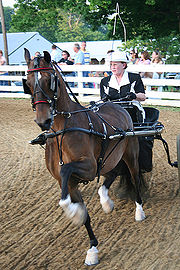
Driving (horse)
Driving, when applied to horses, ponies, mules, or donkeys, is a broad term for hitching equines to a wagon, carriage, cart, sleigh, or other horse-drawn vehicle by means of a harness and working them in this way...
have a breastcollar instead of a horse collar and are made with strong but refined-looking leather throughout, usually black and highly polished. In draft horse showing
Draft horse showing
Draft horse showing refers to horse shows exclusively for horses of the draft horse breeds. In North America, though a small number of draft horses are also shown under saddle, the term "Draft horse showing" refers to a specific horse show competition that primarily features driving exhibitors...
and combined driving
Combined driving
Combined driving also known as Horse Driving Trials is an equestrian sport involving carriage driving. In this discipline the driver sits on a vehicle drawn by a single horse, a pair or a team of four. The sport has three phases: Dressage, Cross-country Marathon and Obstacle Cone Driving and is...
, horse collars are seen, but harness leather is still highly polished and well-finished.
Carriage or van harness
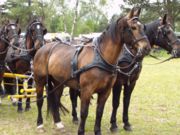
Trace (tack)
In transport, a trace is one of two, or more, straps, ropes or chains by which a carriage or wagon, or the like, is drawn by a harness horse or other draught animal. The once popular idiom: "kick over the traces" comes from a frisky animal kicking one or both feet outside a trace...
attach either to the shafts of the vehicle or to the vehicle itself, and the harness may have either a horse collar
Horse collar
A horse collar is a part of a horse harness device used to distribute load around a horse's neck and shoulders when pulling a wagon or plow. The collar often supports and pads a pair of curved metal or wood pieces, called hames, to which the traces of the harness are attached...
or a breastcollar.
Racing harness

Sulky
A sulky is a lightweight cart having two wheels and a seat for the driver only but usually without a body, generally pulled by horses or dogs, and is used for harness races...
. Most race harnesses incorporate a running martingale
Martingale
Martingale can refer to:*Martingale , a stochastic process in which the conditional expectation of the next value, given the current and preceding values, is the current value*Martingale for horses...
and an overcheck. Sometimes harness racing horses are raced with an "open" bridle, one that does not have blinkers. Specialized equipment, called pacing hobbles, are added to the harness of race horses
Harness racing
Harness racing is a form of horse racing in which the horses race at a specific gait . They usually pull a two-wheeled cart called a sulky, although racing under saddle is also conducted in Europe.-Breeds:...
who pace in order to help them maintain their gait
Horse gait
Horse gaits are the various ways in which a horse can move, either naturally or as a result of specialized training by humans.-Classification:...
.
Cart or wagon harness
Harness for pulling heavier vehicles always has a horse collarHorse collar
A horse collar is a part of a horse harness device used to distribute load around a horse's neck and shoulders when pulling a wagon or plow. The collar often supports and pads a pair of curved metal or wood pieces, called hames, to which the traces of the harness are attached...
. The traces are often made of chain and attach to loops on the shafts of the vehicle. A chain attached to the shafts may be passed over the saddle to carry their weight. Reins are of rope or leather, depending on region of the world.
Plow harness
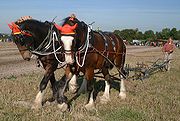
Harrow (tool)
In agriculture, a harrow is an implement for breaking up and smoothing out the surface of the soil. In this way it is distinct in its effect from the plough, which is used for deeper tillage. Harrowing is often carried out on fields to follow the rough finish left by ploughing operations...
s, canal boat
Narrowboat
A narrowboat or narrow boat is a boat of a distinctive design, made to fit the narrow canals of Great Britain.In the context of British Inland Waterways, "narrow boat" refers to the original working boats built in the 18th, 19th, and 20th centuries for carrying goods on the narrow canals...
s or logs. This style is also used on the leaders in a team of animals pulling a vehicle. The traces attach to a whippletree
Whippletree (mechanism)
A whippletree or whiffletree is a mechanism to distribute force evenly through linkages. The mechanism may also be referred to as an equalizer, leader bar or double tree. It consists of a bar pivoted at or near the centre, with force applied from one direction to the pivot, and from the other...
behind the horse and this then pulls the load (or in larger teams may attach to further whippletrees).
See also
- Combined drivingCombined drivingCombined driving also known as Horse Driving Trials is an equestrian sport involving carriage driving. In this discipline the driver sits on a vehicle drawn by a single horse, a pair or a team of four. The sport has three phases: Dressage, Cross-country Marathon and Obstacle Cone Driving and is...
- Dog harnessDog harnessA dog harness is piece of equipment for dogs, generally similar to harness tack for horses. There are various designs depending on the type of use, whether it be for assistance to a disabled person, hauling a cart or sled, or pulling a human being, such as in skijoring or pulka...
- Draft horse showingDraft horse showingDraft horse showing refers to horse shows exclusively for horses of the draft horse breeds. In North America, though a small number of draft horses are also shown under saddle, the term "Draft horse showing" refers to a specific horse show competition that primarily features driving exhibitors...
- Driving (horse)Driving (horse)Driving, when applied to horses, ponies, mules, or donkeys, is a broad term for hitching equines to a wagon, carriage, cart, sleigh, or other horse-drawn vehicle by means of a harness and working them in this way...
- Horse tackHorse tackTack is a term used to describe any of the various equipment and accessories worn by horses in the course of their use as domesticated animals. Saddles, stirrups, bridles, halters, reins, bits, harnesses, martingales, and breastplates are all forms of horse tack...
- Horse collarHorse collarA horse collar is a part of a horse harness device used to distribute load around a horse's neck and shoulders when pulling a wagon or plow. The collar often supports and pads a pair of curved metal or wood pieces, called hames, to which the traces of the harness are attached...
- Horse brassHorse brassA horse brass is a brass plaque used for the decoration of horse harness gear, especially for shire and parade horses. they became especially popular in England from the mid-19th century until their general decline alongside the use of the heavy horse, and remain a collectors item today.-History:In...
- Harness racingHarness racingHarness racing is a form of horse racing in which the horses race at a specific gait . They usually pull a two-wheeled cart called a sulky, although racing under saddle is also conducted in Europe.-Breeds:...
- Horse-drawn vehicleHorse-drawn vehicleA horse-drawn vehicle is a mechanized piece of equipment pulled by one horse or by a team of horses. These vehicles typically had two or four wheels and were used to carry passengers and/or a load...
- Shaft bowShaft bowA shaft bow is an element of horse harness that is attached to the front of the shafts of a horse-drawn vehicle and joins them by arching high above the neck of the horse. Use of the shaft bow is widespread in the area east of the Baltic Sea . A shaft bow is also used in traditional harness in...

